ESP-MACCS / CubeMAP
EO
ESA
Approved
UKSA
ESP-MACCS (Earth System Processes Monitored in the Atmosphere by a Constellation of CubeSats), also known as CubeMAP, is a constellation of three satellites as an European Space Agency (ESA) Scout mission. ESA’s Scout missions are designed to send miniature satellites to space to gather meaningful scientific information with regard to the Earth and its processes. ESP-MACCS will be utilised to quantify atmospheric processes in the upper troposphere and stratosphere.
Quick facts
Overview
| Mission type | EO |
| Agency | ESA, UKSA |
| Mission status | Approved |
| Instruments | TIS (ESP-MACCS), VNIR Hyperspectral Solar Disk Imager (ESP-MACCS) |
| CEOS EO Handbook | See ESP-MACCS / CubeMAP summary |
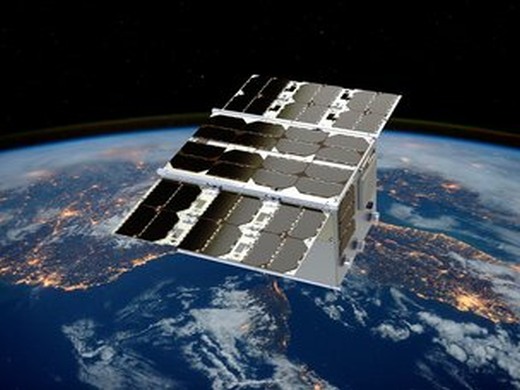
Summary
Mission Capabilities
ESP-MACCS will carry a High resolution InfraRed Occultation Spectrometer (HIROS), and a near-infrared Hyperspectral Solar Disc Imager (HSDI). These will be used to observe gases which include water vapour, carbon dioxide, methane, ozone and nitrous oxide, as well as aerosols.
Performance Specifications
HIROS has a spectral resolution that ranges from 0.2 mm to 0.02 mm, and a field of view (FOV) of <0.5 mrad @ 25 mm mirror diameter. The laser wavelength ranges from 8 - 12 μm. HSDI images with a pixel resolution of 2048 x 1088 across 16 spectral channels in the visible (VIS) and near-infrared (NIR) spectra.
Space and Hardware Components
The satellites are designed for an operational life of two years in orbit to cover more than one full annual cycle, with the aim of extending the mission to four years to capture the effects of the El Niño Southern Oscillation.
Overview
As part of its approach of embracing the concept of New Space through the FutureEO programme, ESA has selected one of four proposals as the first ‘Scout’ mission. This decision paves the way to starting negotiations with GomSpace in Denmark who will lead an industrial consortium for the development of a small-satellite mission called Earth System Processes (ESP) Monitored in the Atmosphere by a Constellation of CubeSats (MACCS). 1)
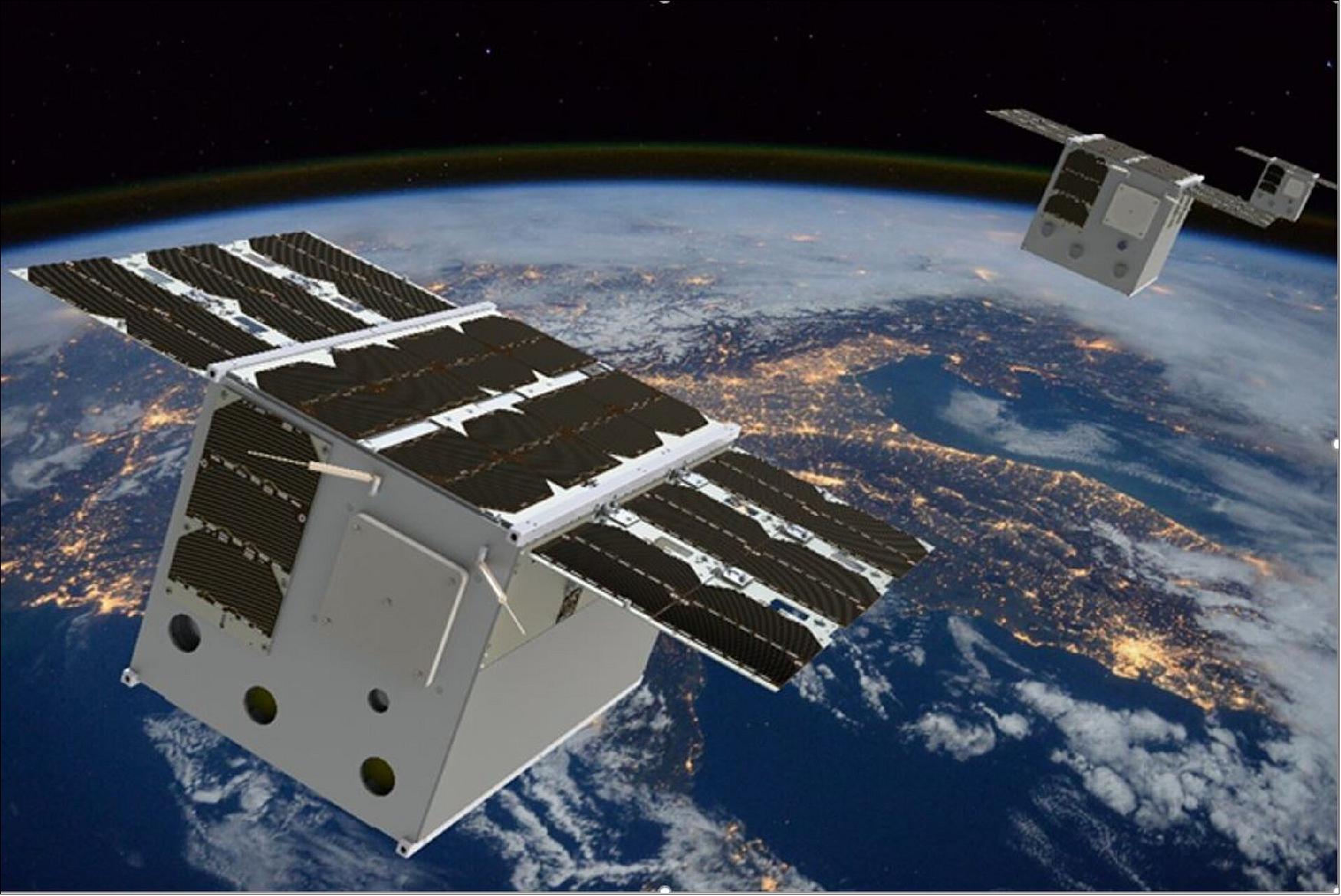
Scout missions are a new element in ESA's Earth Observation Programme. The idea is to prove new concepts using small satellites that add scientific value to data from current satellites. Adopting an agile development process, the aim is to realise a Scout mission for a maximum of €30 million. This cost includes the development of the space and ground segments, launch and in-orbit commissioning – and from kick-off to launch within three years.
Member States participating in the FutureEO programme selected EPS-MACCS at a recent Programme Board for Earth Observation meeting.
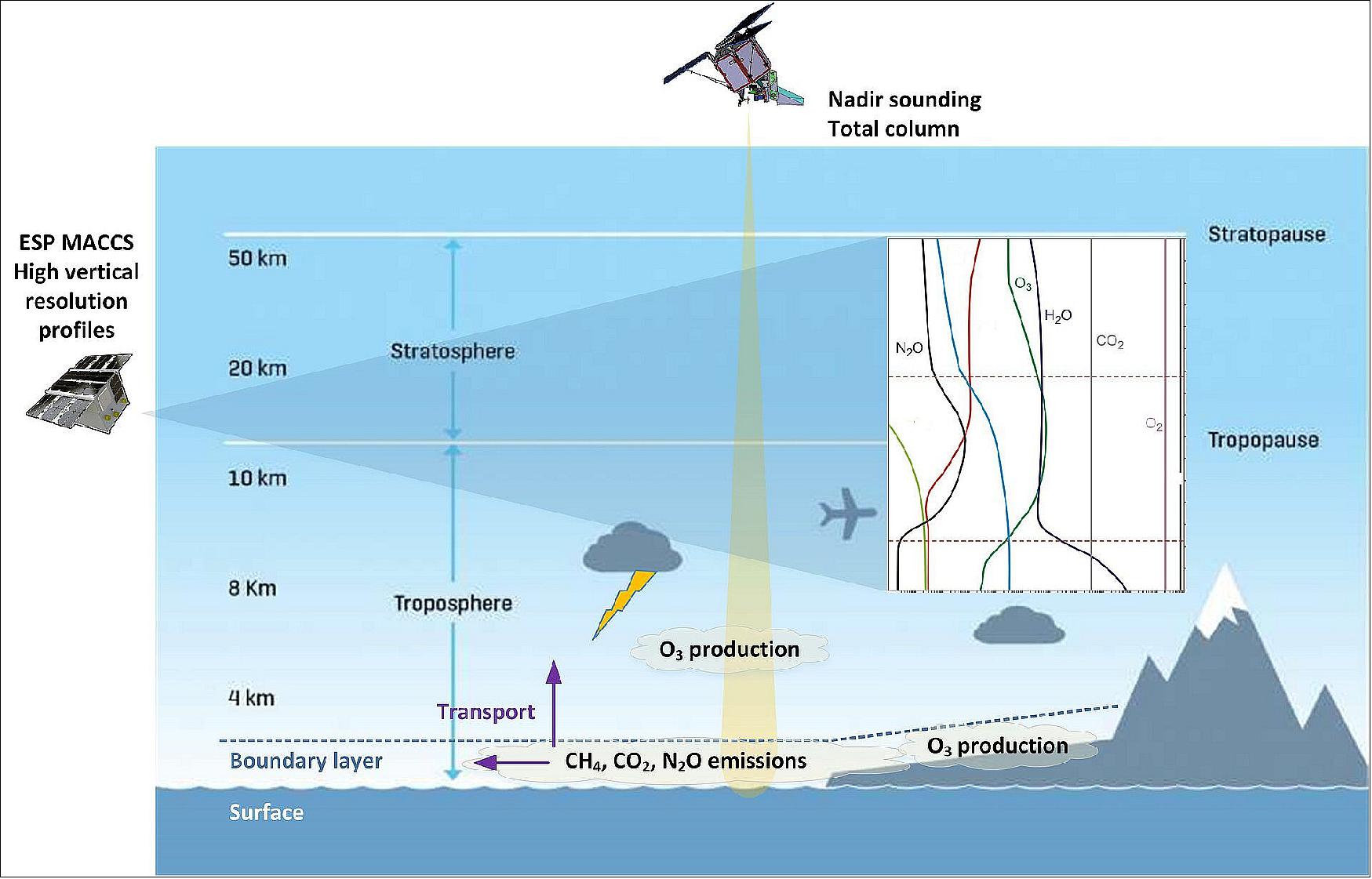
ESA’s Head of Earth Observation Future Missions & Instruments Division, Philippe Martimort, said, “We had four excellent proposals on the table, which not only demonstrates interest in the programme, but also the potential that CubeSats have of providing valuable science to understand our world and how they can be used to complement traditional larger satellite missions.”
Spacecraft
The spacecraft will be built by a consortium of organisations led by GomSat, a Danish satellite company. This will include Rutherford Appleton Laboratory in the United Kingdom, GomSpace in Luxembourg and in Sweden, Enpulsion in Austria, Hyperion in the Netherlands and Kongsberg Satellite Services (KSAT) in Norway. The spacecraft will operate in a constellation of three satellites.
The satellite is expected to have a 12U form factor (2U x 2U x 3U), and inherits the flight platform of past GomSpace missions that include the GOMX missions. It is expected to weigh in at 17.78 kg, with an Orbit Average Power (OAP) ranging between 16.71 and 32.08 W.
The Attitude and Orbit Control Systems (AOCS) expected to be used include the Hyperion ST200 star tracker for fine attitude determination, and the Enpulsion IFM NanoThruster electric propulsion system for orbit control.
The on-board computer will have 512 MB of storage, and up to 32 GB of storage for the Software Defined Radio (SDR).
The Command & Data-handling System (C&DH) utilises the NanoMind A3200 as the on-board computer, using GomSpace mission software. This computer was chosen due to its proven flight heritage on other satellites. Lastly, the communications on the satellite will be transmitted and received in S-band radio.
Mission Status
• December 10, 2021: ESA has signed a contract with GomSpace to build the Scout CubeMAP mission. Embracing the concept of New Space, CubeMAP is a trio of nanosatellites to help quantify atmospheric processes in the upper atmosphere and how they impact our climate. The constellation will measure water vapour, carbon dioxide, methane, ozone, nitrous oxide and aerosols – all of which play a key role in the greenhouse effect and climate change. 2)
- The contract, worth €24 million, was signed by ESA’s Acting Director of Earth Observation Programmes, Toni Tolker-Nielsen, and CEO of GomSpace, Niels Buus.
- This is the second contract to be signed for the build of a Scout mission, following the signature with Surrey Satellite Technology Ltd for HydroGNSS in October.
- Complementing ESA’s series of Earth Explorer research missions, Scout missions are a new element in ESA's Earth Observation FutureEO Programme. The aim is to demonstrate the capability of nanosatellites to deliver value-added science, either by the miniaturisation of existing technologies or by demonstrating new sensing techniques. The aim is also to achieve this quickly – within three years from kick-off to launch.
- “A Scout mission consists of one or several small satellites for rapid prototyping and demonstration purposes of novel Earth observation techniques for Earth science and related non-commercial applications. Scouts demonstrate disruptive sensing techniques or incremental science, while retaining the potential to be subsequently scaled up in larger missions or implemented in future ESA Earth Observation programmes.”
- “CubeMAP will focus on the upper troposphere and lower stratosphere at tropical and subtropical latitudes, where megacities and their associated anthropogenic greenhouse gas emissions grow fast. Each of the three satellites in the constellation carries three miniaturised ultra-high spectral resolution laser heterodyne spectro-radiometers and one miniaturised hyperspectral solar disk imager.”
- CubeMAP is unique in that it will fly the first European heterodyne spectrometers for atmospheric measurements. These will be designed, produced, tested and integrated in less than three years, yet another industrial challenge on top of the scientific and programmatic challenges.
- The mission is designed to have an operational life of two years in orbit to cover more than one full annual cycle, with the aim of extending the mission to four years to capture the effects of the El Niño Southern Oscillation.
- With the contract now signed, GomSpace in Denmark will lead an industrial consortium to build CubeMAP. The consortium includes Rutherford Appleton Laboratory in the UK, GomSpace in Luxembourg and in Sweden, Enpulsion in Austria, Hyperion in the Netherlands and KSAT in Norway.
• September 23, 2020: Climate change is one of the most critical challenges humankind faces and it is urgent to provide scientists with all the data and tools needed to understand the complex system the Earth is. 3)
- In September 2020, World Ozone Day commemorated the 35th anniversary of the Treaty of Vienna and 35 years of global ozone layer protection. It is clearer nowadays that climate change is one of the most critical challenges humankind faces and it is urgent to provide scientists with all the data and tools needed to understand the complex Earth system.
- Understanding and quantifying the processes driving the change and particularly the role played by the atmosphere is necessary, and the CubeMAP mission has been designed to address this need. Over the last months, GomSpace and RAL Space (UK) have been jointly consolidating the mission as part of ESA's SCOUT challenge. The mission goal is to study, understand, and quantify processes in the tropical Upper Troposphere and Stratosphere (UTS), study its variability, and contribute to trends analysis in its composition and its effects on climate and vice-versa. The UTS composition plays a significant role in controlling the Earth’s climate, with still poorly explored feedbacks within the Earth System.
- The team will present the mission and the findings to the ACEO (Advisory Committee for Earth Observation) members in October for the final evaluation and selection.
• 2018: Earth is changing at an unprecedented pace. One of the most pressing global issues faced by humankind relates to climate change, now recognized to be largely driven by human activity. The awareness of the socio-economic impact has also been growing and so has the international consensus on the urgency of understanding and limiting impacts. To do so, understanding and quantifying the processes driving the change and particularly the role played by the atmosphere is necessary, and the ESP -MACCS mission has been designed to address this need. 4)
- The ESP-MACCS mission has been selected for consolidation as part of the ESA SCOUT mission challenge. The mission was initiated by a core international science team and is developed through a cooperation between GomSpace (Denmark) and RAL Space (UK). The mission consolidation phase is scheduled to conclude in summer 2020, date at which evaluation and decision for implementation will be made.
- ESP-MACCS consists of a constellation of three identical CubeSats, each equipped with three high resolution spectrometers and one hyperspectral solar disk imager. The overall mission goal is to study, understand, and quantify processes in the Upper Troposphere and Stratosphere (UTS), study its variability, and contribute to trends analysis in its composition and its effects on climate and vice-versa. The UTS composition plays a significant role in controlling the Earth’s climate, with still poorly explored feedbacks within the Earth System. This region of the atmosphere is coupled to the surface and the free troposphere both dynamically and radiatively. Its composition is determined by anthropogenic emissions of greenhouse gases and pollution precursors and is subject to changes via radiative, dynamical, and chemical processes.
- The ultra-miniature, while high spectral resolution, spectrometers selected for the payload are integrated thermal infrared laser heterodyne spectroradiometer. These have been well demonstrated through ground-based solar occultation measurements and were shown to resolve fundamental ro-vibrational molecular transitions, from which vertical profiles of atmospheric constituents are derived. Their ultra miniature package combined with high spectral resolution is achieved by targeting optimised narrow spectral windows.
- For aerosol measurements and oxygen measurements, an innovative, co-registered, solar disk imager using a multispectral CMOS sensor ensures both pointing knowledge accuracy and a large spectral channel diversity in the visible and near infrared, together with a small form factor.
- The platform selected for the mission is expected to be based on the GomSpace 12U CubeSat form factor which can accommodate the payloads while also keeping volume, mass and cost at a manageable level. The system design is to a high degree based on proven GomSpace COTS products with demonstrable flight heritage, hence lowering the mission risk.
- The mission contributes to nurturing a novel observation paradigm: it offers a high level of deployment flexibility and system modularity, as well as economy of scale, through the use of identical payloads and platforms functionalized to specific Earth observation goals. The constellation approach also obviates the traditional limited coverage of limb solar occultation mission. ESP-MACCS is highly complementary to the nadir sounding infrastructure and contributes to enhancing its outputs and exploitations. It also addresses the forthcoming gap in solar occultation sounding capabilities.
Sensor Complement
The sensors intended to be included on board includes three miniaturised ultra-high spectral resolution laser heterodyne spectro-radiometers and one miniaturised hyperspectral solar disk imager. These are designed to fit within the smaller 12U CubeSat form factor that ESP-MACCS is based on.
High resolution InfraRed Occultation Spectrometer (HIROS)
HIROS is an ultra-high spectral resolution laser heterodyne spectro-radiometer utilised for solar occultation atmosphere sounding.5) HIROS relies on heterodyne detection transposed in the optical domain. As such, tuning the local oscillator allows for the resolution of the optical spectrum to be resolved within the tuning range of the laser, with noise limited to photon shot noise. This approach leads to the ability to obtain ultra-high spectral resolution in miniature packages. Spectral channels are sequentially acquired through the local oscillator laser, performing a frequency sweep. This yields a suitable signal-to-noise ratio (SNR) in limb solar occultation observation modes, which makes this a simple and cost-effective method. With three HIROS instruments on board, their main objective is to collect data with three different spectral windows that target detection of different gases.
|
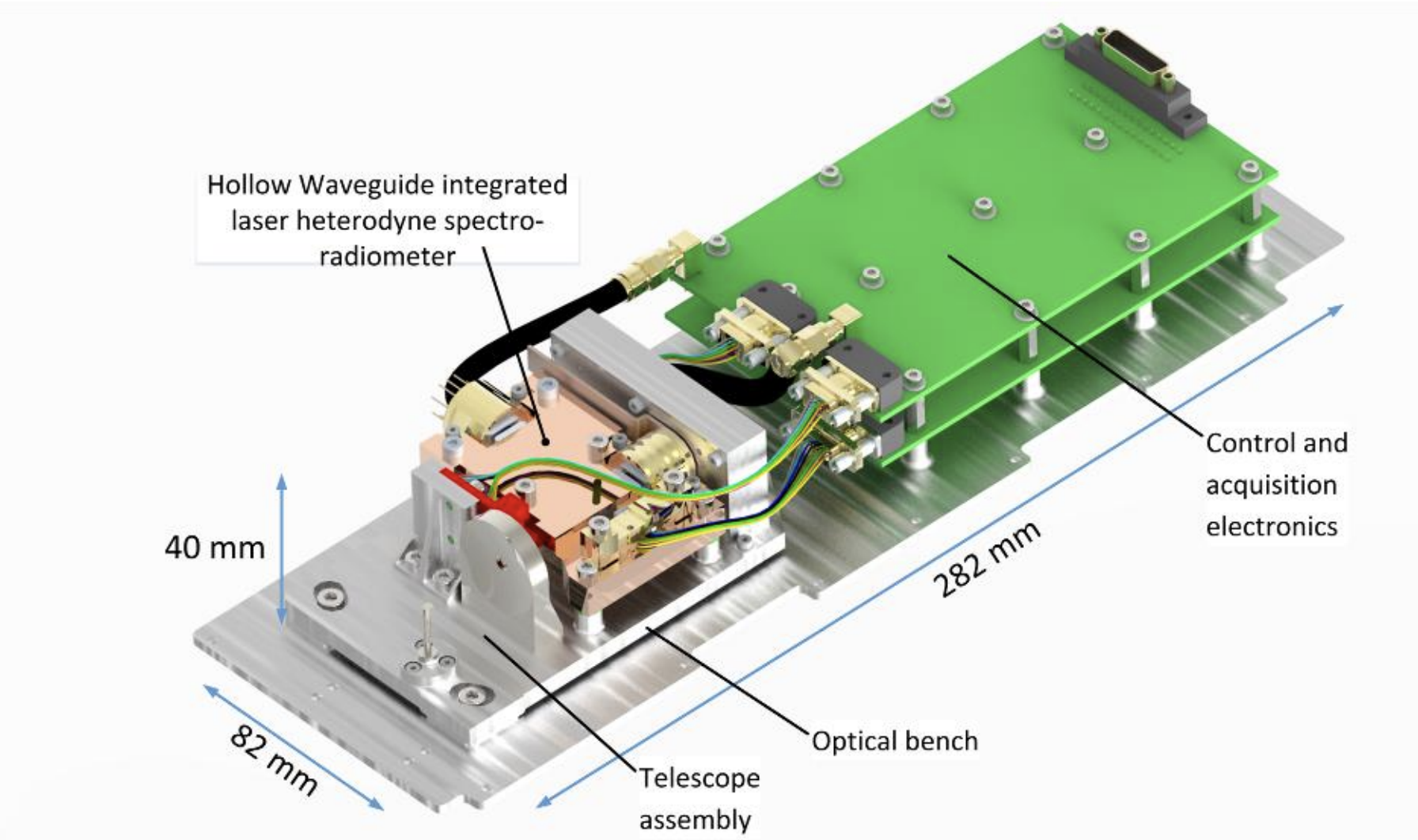
Hyperspectral Solar Disc Imager (HSDI)
The main objective of HSDI is to ensure the pointing direction of the spacecraft is known, and as such the corresponding sounding geometry can be reconstructed. This instrument also allows for aerosol extinction measurements as well as oxygen A band measurements that are able to derive pressure or air mass. Turning the solar disk imager adds a visible spectrum and near-infrared (VIS and NIR) operating instrument to the payload, reducing costs and increasing payload efficiency.
To fulfil the miniaturisation and cost-effectiveness requirements enabling the constellation, a Multi Spectral Filter Array (MSFA) in place of a standard CMOS imager is used. ESP-MACCS uses a standard MSFA from IMEC based on CMOSIS CMV2000, made of 16 spectral channels with bandpass Δλ of ~16 nm in the VIS/NIR. The sensor will provide a noise equivalent transmission of 10-4 in each band. The bands are suitable for O2, H2O column retrieval, as well as aerosol extinction coefficients. Unlike other aerosol remote sensing techniques such as LIDAR and limb scattering sensors, ESP-MACCS will measure the aerosol extinction directly and does not need any assumptions on the particle type and size distribution. This is therefore, the ultimate aerosol remote sensing solution for the upper troposphere and lower stratosphere regions.
To image the sun onto the mosaic sensor, an achromatic doublet is used. The layout has been folded to ensure compactness and the correct position of the focal plane. The folding is done in-plane, except for the last mirror that sends the beam to the sensor installed on the electronic board. The telescope is diffraction limited at all wavelengths. It fits in an envelope of 10x10x3.1 cm3 , weighs 540 g (including margins) and consumes up 3.5 W in readout mode. Due to its design, it is relatively insensitive to uniform thermal variations.
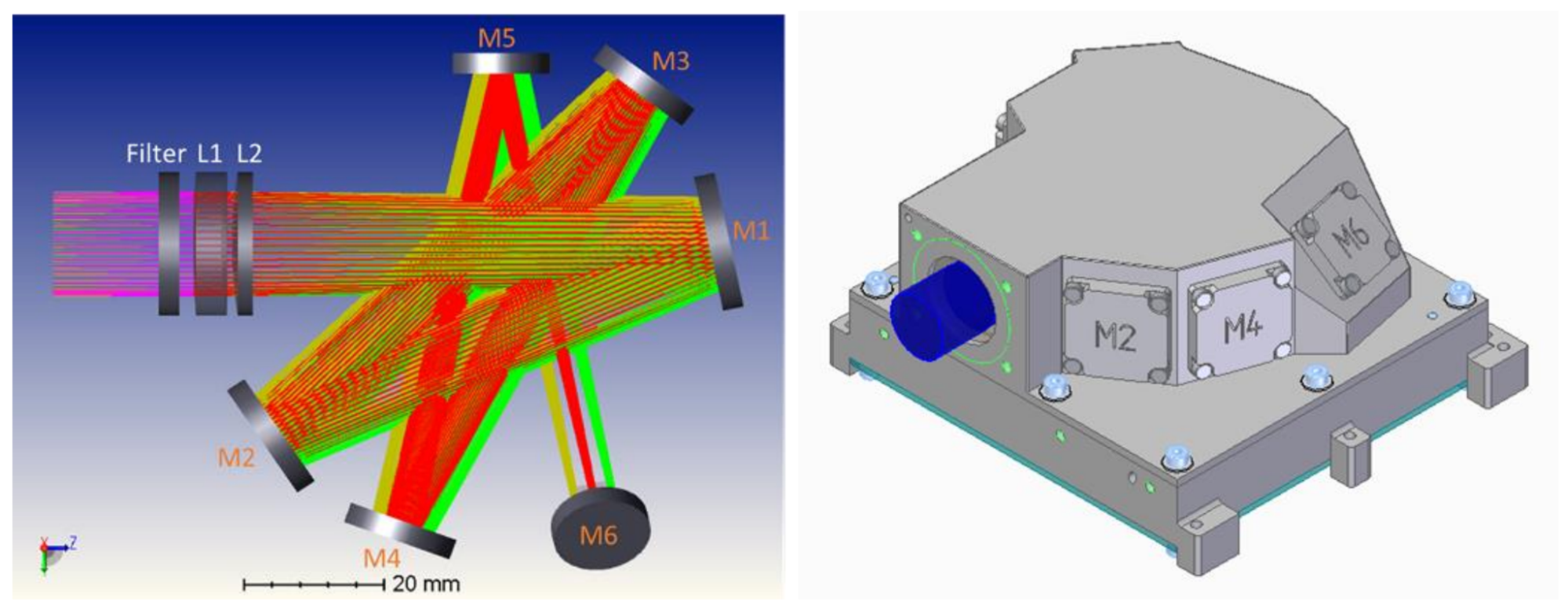
References
1) “ESA paves the way for first Earth observation Scout mission,” ESA Applications, 03 December 2020, URL: https://www.esa.int/Applications/Observing_the_Earth/ESA_paves_the_way_for_first_Earth_observation_Scout_mission
2) “Contract signed to build Scout CubeMAP,” ESA Applications, 10 December 2021, URL: https://www.esa.int/Applications/Observing_the_Earth/Future_EO/Contract_signed_to_build_Scout_CubeMAP
3) “GomSpace and RAL Space jointly consolidating ESA's SCOUT challenge,” GomSpace News, 23 September 2020, URL: https://gomspace.com/news/gomspace-and-ral-space-jointly-consolidating-esas-.aspx
4) “Earth System Processes Monitored in the Atmosphere by a Constellation of CubeSats (ESP-MACCS) – a.k.a CubeMAP,” RAL Space Spectroscopy Group, 2018, URL: http://www.ralspace-spectroscopy.com/?p=482
5) Weidmann, Damien. CubeSats for Monitoring Atmospheric Processes (CubeMAP): a constellation mission to study the middle atmosphere. 2020. CentAUR: Central Archive at the University of Reading, Space Science and Technology Department (RAL Space), https://centaur.reading.ac.uk/93219/3/12Oct2020CubeMAP_paper_ProcSPIETemplate_A4_v2.pdf . Accessed December 2022.